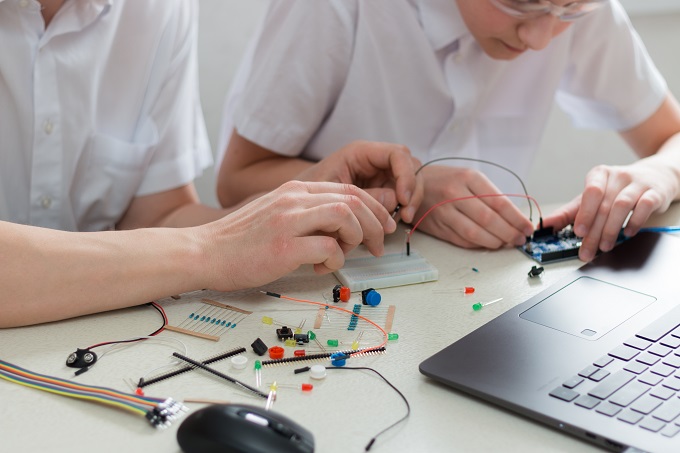STEAM: Creating future problem solvers
Flexible thinking, innovate mindsets and social and cultural awareness make STEAM education important for students of all ages.

The benefits of STEAM (Science, Technology, Engineering, Arts and Maths) learning are well-documented. Interdisciplinary at its core, STEAM weaves subjects together to engage and inspire students, while bringing these concepts to life using real world examples.
Read the Term 1 edition of School News HERE.
STEAM encourages ākonga to think outside of the traditional, siloed disciplines of Science, Technology, Engineering, Arts and Math. Instead, students combine these subject areas to investigate new fields like bioengineering. That means a curriculum that incorporates STEAM is a future-focused one, as many areas of investigation, and even new disciplines, are being born from investigating any number of combinations of STEAM. For example, data visualisation and data science combine design principles, mathematics and technology.
The inclusion of the arts, or the “A” in STEAM, is a natural progression from STEM pedagogies. In a recent literature review of international STEAM learning, researchers noted that the addition of arts may help student understanding of STEM subjects, improving student performance in all areas of the curriculum. Researchers also noted that arts integration is not limited to creative design, but may also incorporate language and humanities as subjects of interest in a wider STEAM project. This ensures STEAM inquiries result in “meaningful expressions and applications of engineering, maths and science”, which strengthens student learning by developing connections between inquiry and real-world problem solving.
As a field, the arts is broad and diverse, covering areas including photography, architecture, history and performance. This allows educators the opportunity to blend STEAM thinking into many subject areas in a variety of ways. The wide spectrum of arts education opportunities can help teachers integrate elements of the arts into their lessons.
Similarly, the variety of disciplines within the arts allows teachers to incorporate STEM principles into their arts classrooms. Students who struggle with principles of maths and science, or find technology daunting may be encouraged to engage with these subjects through their arts practice. Shifting the focus from science or maths, for example, in isolation and adopting an integrated approach can make concepts more accessible. Recontextualising STEM learning within an arts framework can encourage students to engage with these concepts.
According to the Ministry of Education’s eLearning website, Te Kete Ipurangi, STEAM encourages students to: think flexibly; feel safe expressing new ideas; become familiar with hands-on learning; take ownership over learning; build teamwork; understand the connections between science, technology, engineering, arts and math and how they can work together and; foster curiosity about the world and how they can change it.

One of the documented benefits of STEAM education is a more effective pedagogy, resulting in demonstrably improved application and understanding of science and mathematics. These two subjects are notoriously difficult to teach, and it’s been internationally noted that standardised assessment in these subject areas often encourages rote learning and memorisation rather than meaningful understanding.
The effectiveness of STEAM in engaging students has also been demonstrated locally. One New Zealand study piloted a co-creationary and open-ended project-based STEAM curriculum for Year 4 students, and observed that “the level of engagement for students began to lift because of the hands-on nature of sessions”. By emphasising the learning process rather than outcomes, the study found many students were achieving well and discovering intrinsic motivation to engage with the exercises. Students also felt empowered through the co-creation of inquiry.
The importance of STEAM for the next generation
The Ministry of Education’s Te Kete Ipurangi recognises the importance of providing STEAM learning opportunities within the New Zealand curriculum.
“STEAM-based programmes take an integrated approach to learning and teaching, which requires an intentional connection between curriculum learning objectives, standards, assessments, and lesson design/implementation,” the website reads.
“STEAM learning applies meaningful maths, science, and technology content to solve real-world problems through hands-on learning activities and creative design.”
Te Kete Ipurangi also touches on the importance of using STEAM to equip students for the future workforce.
“STEAM learning will not only produce tomorrow’s designers and engineers; it will develop innovative mindsets and the ability to problem-solve, ensuring that our students become creators of technology, not just passive consumers.”
Through exposure to the arts, students’ cultural and social awareness is increased. This in turn can help foster an appreciation and understanding of other world views. Remaining open to alternative viewpoints and different lived experiences may encourage new approaches to problems. Shifts in social consciousness and a recognition that problems should often be viewed in a global, rather than local context make this educational exposure valuable. Today’s young people will require the ability to look beyond their own backyard, and incorporate broader contexts in their approach to tasks.
Incorporating the arts and humanities into STEM learning is therefore essential not just to learning, but for the next generation of innovators and creators. By incorporating and considering the effects of technologies on society, STEAM creates flexible problem solvers that can approach problems in multi-faceted ways, creating thinkers who may solve future problems such as AI bias, technological discrimination and other inequalities that currently exist within our digital and technological landscape. When teaching interdisciplinary topics, requiring flexible thinking, the arts and humanities are necessarily essential to effective learning, as it encourages metacognitive thinking, examining how we as society and people interact with the technologies we create.
How can I incorporate STEAM learning in my classroom?
STEAM activities often emerge from real-life problems, allowing for student-driven projects. The 2022 inquiry into the benefits of STEAM in a New Zealand context successfully raised student engagement with STEAM inquiries into waste, product design and more. Significantly, the New Zealand curriculum recently added resources for adding STEAM learning to Pasifika Education.
Added to the Pasifika Education Community website, the new series uses posters and videos to demonstrate how Pacific peoples were always scientists, technologists, engineers, artists and mathematicians. Five short videos and downloadable posters illustrate how Pacific peoples embody innovation, creativity, and resourcefulness. The resources provide specific examples of STEAM within traditional Pacific Island culture and practices.
Educators can use the resource to “encourage students to study STEAM subjects and carry their ancestors’ legacy into the future”.









Hi Naomi. I noticed that you wrote “In a recent literature review of international STEAM learning, researchers noted that the addition of arts may help student understanding of STEM subjects, improving student performance in all areas of the curriculum.” What was the title of the review you were referring to?
Kia ora Aaron, here’s the full citation – Belbase, S., Bhesh Raj Mainali, Wandee Kasemsukpipat, Hassan Tairab, Munkhjargal Gochoo & Adeeb Jarrah. “At the dawn of science, technology, engineering, arts, and mathematics (STEAM) education: prospects, priorities, processes, and problems”, International Journal of Mathematical Education in Science and Technology no 53, vol. 11 (2022), 2919-2955, DOI: 10.1080/0020739X.2021.1922943.
Happy reading!